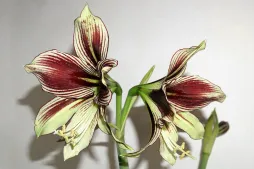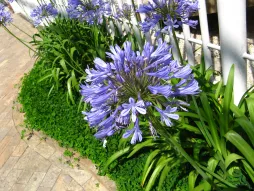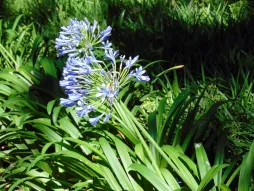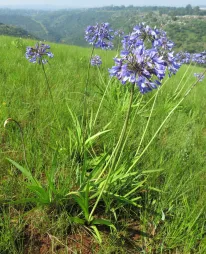Hybrid Hippeastrum, the florist's Amaryllis
Amaryllis 'Charisma', 'Dancing Queen' or 'Minerva'... Behind these mysterious names lies a secret: these plants are not amaryllis. Although these varieties belong to the Amaryllidaceae family, they are actually part of the Hippeastrum genus. They are hybrids obtained by horticulturists to give us flowers of every color!
How to recognize hybrid Hippeastrum, the florist's Amaryllis?
Hybrid amaryllis are bulbous, flowering plants. They reach a height of 90 centimetres and a spread of 30 centimetres. But some dwarf varieties are no taller than 40 centimetres.
One or more upright flower stems emerge from the fleshy bulb. These sturdy, hollow stems can reach 60 cm in height and bear the flowers.
Unlike amaryllis belladonna (the botanical amaryllis), Hippeastrum retains evergreen foliage. Its long, green, ribboned leaves form a tuft at the base of the plant.
They come in a wide range of shapes and colors, depending on the cultivar .There are varieties with :
- Single or double ('Aphrodite' and 'Blossom Peacock') ;
- Red ('Red Lion', 'Baby Star') ;
- White ('White Nymph', 'Christmas gift') ;
- Roses ('Apple Blossom', Neon') ;
- Orange ('Orange Sovereign');
- Plain, striped or multicolored.
Regardless of flower shape or color, Hippeastrum is toxic if swallowed. Make sure your pets, especially your cats, don't nibble the leaves of your florist's amaryllis.
Our maintenance tips
For your Florist's amaryllis to flourish, you need to respect its natural rhythm and dormant phase.
Watering
Adapt watering during the growing season.
The florist's Amaryllis must keep substrate fresh, but not soggy. Water when the soil has dried a centimeter.
Use room-temperature water, preferably non-calcareous (e.g. Rainwater).
Drain off any water stagnating in the saucer or planter. It may rot the roots.
During the rest of the year, adjust the watering frequency of your Hippeastrum ×hortorum.
Once flowers and leaves have faded, reduce watering. Water sparingly to prevent the soil from drying out completely.
Repotting
Obtain a perforated pot at least 25 centimetres in diameter and a well-draining substrate. You can mix potting soil for green plants andsand, for example.
Plant your amaryllis for florists in the center. The bulb should not touch the sides and its tip should point upwards. Add potting soil without covering the bulb completely. It should only be half-buried.
Water lightly for the first time to help the bulb take root.
Fertilization
Apply fertilizer to stimulate growth.
Apply a liquid fertilizer for green plants. Respect the doses indicated by the manufacturer on the packaging. Too high a dose will damage foliage.
Apply fertilizer to encourage growth.
Apply a liquid fertilizer for green plants. Respect the doses indicated by the manufacturer on the packaging. Too high a dose will damage foliage.
Cleaning
The dust that accumulates on foliage hinders photosynthesis and the growth of your Florist's amaryllis. You can remove it with a damp cloth or clean sponge.
Prune
When the flower fades, prune the flowering stem flush with the foliage.
Do not touch the leaves while they are green. The plant needs them to replenish its reserves. When they are completely dry, you can remove them.
Cutting
Dig up your Hippeastrum ×hortorum to separate the bulbs from the mother plant. Using your hands or a clean, sharp tool such as a knife, cut off a bulb. Make sure it has roots and a portion of stem.
Prepare a perforated pot at least 25 centimetres in diameter. Fill it with a rich, well-draining substrate, such as a mixture of potting soil and sand.
Plant your amaryllis for florists in the center. Cover with substrate, but allow the tip to protrude by about two to five centimetres.
Water lightly to promote contact between the bulb and the soil.
Information
| Family | Amaryllidaceae - Amaryllidaceae |
| Type | Hippeastrum - Hippeastrum |
| Species | Florist's Amaryllis - Hippeastrum ×hortorum |
| Lifecycle | Perennial |
| Foliage | Evergreen |
| Substrats | |
| Planting methods |
Open ground In pots In tubs |
| Categories | |
| Tags |
Flowery Fritillary Toxic |
| Origin |
South America |
| Hardiness (USDA) | 11a |
| Leaf color |
|
| Flower colors |
|
Discover plants from the same family

Amaryllis butterfly
Discover

Agapanthus africanus
Discover

Early Agapanthus
Discover

Agapanthus campanulatus
Discover

















